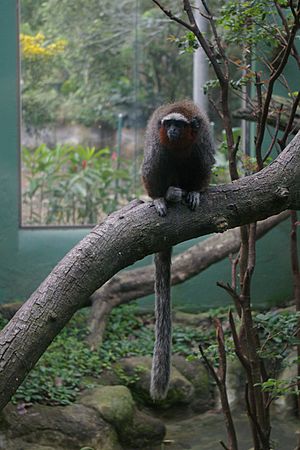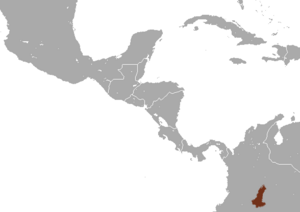Ornate titi monkey facts for kids
Quick facts for kids Ornate titi |
|
|---|---|
 |
|
| Ornate titi in Cali Zoo | |
| Conservation status | |
| Scientific classification | |
| Genus: |
Plecturocebus
|
| Species: |
ornatus
|
 |
|
| Ornate titi range | |
| Synonyms | |
|
Callicebus ornatus Gray, 1866 |
|
The ornate titi monkey (Plecturocebus ornatus) is a small and fluffy type of titi monkey. It belongs to a family of monkeys called Pitheciidae, which also includes uakaris and saki monkeys. All these monkeys are known as New World monkeys, meaning they live in Central and South America.
The ornate titi lives only in eastern Colombia. It is the only titi monkey from its group found so far north. It lives about 350 kilometers away from its closest relative, the white-tailed titi. These two were once thought to be the same species, but now scientists know they are different. The ornate titi also spends a lot of its time on the ground.
This monkey is listed as "Vulnerable" on the IUCN Red List of endangered species. This means its population is decreasing, and it needs protection.
Contents
About the Ornate Titi
The ornate titi has a thick, soft, and fluffy coat. Its ears and forehead are white. Its hands and feet are grey. The rest of its body is a bright chestnut red. Its tail is dark reddish-brown or black, with a white tip. Like most titi monkeys, its tail is longer than its body.
Male and female ornate titis look very similar. However, females are usually a bit bigger. Males are about 633 millimeters long, while females average 752 millimeters.
Where Ornate Titis Live
Habitat and Threats
The ornate titi lives in specific parts of Colombia. These areas include the departments of Cundinamarca and Meta. They prefer tropical and subtropical forest areas. They especially like places with lots of dense plants. This includes thick bushes, tangled vines, and even wet or flooded spots.
Ornate titis often sleep in vine tangles on small tree branches. They usually choose sleeping spots at least 15 meters (about 50 feet) above the ground. These monkeys can handle some changes in their habitat, like seasonal floods. They are often found in forests that have been disturbed by humans. They can even do well in very disturbed areas.
However, human settlements are growing, which means less space for the ornate titi. Their habitat is shrinking and becoming broken up. The area where they live has gone down by 30% in the last 24 years. Because of this, the IUCN has listed them as "Vulnerable" since 1994. Their population is also decreasing.
What Ornate Titis Eat
The ornate titi is an omnivore, meaning it eats both plants and animals. But mostly, they eat fruit. About 70% of their diet is fruit. They also eat leaves (about 26%) and a very small amount of insects (less than 1%). They often prefer fruit that is not yet ripe. They also like fruit from smaller trees, as it's easier to find a lot of it there.
They also eat small insects, usually less than 2 centimeters long. These can include moths, butterflies, cocoons, spiders, and ants. They are even good at catching flying insects in the air!
When it comes to leaves, they prefer small leaves and buds. During the dry season, they eat more vines and bamboo.
Daily Life and Reproduction
Lifestyle
Because they eat mostly plants, ornate titis spend a lot of time sleeping. They usually sleep for about 60% of the day. This is much more than the white-tailed titi, which sleeps less than 25% of the time.
Ornate titis are diurnal, meaning they are active during the day. They wake up early in the morning and stay active until sunset. Their activity depends on the season. In warmer months, there's more fruit, so they are more active. In colder months, they might stay in their sleeping spot for up to four hours after sunrise. A titi's active day usually lasts about 11.5 hours. They spend about 2.7 hours of this time eating.
Their day usually has two main feeding times: one in the morning and one in the evening. They rest around midday. The last few hours of the day are often spent eating leaves.
Predators
The main predators of titi monkeys are raptors, which are birds like eagles and hawks. Some raptors seen attacking titis include the Guianan crested eagle and the ornate hawk-eagle. Tufted capuchins, another type of monkey, have also been seen hunting and eating ornate titis.
Reproduction and Life Cycle
Ornate titis are monogamous, meaning a male and female pair stay together. The father does most of the parenting. He carries the baby, only passing it to the mother for feeding. Babies are usually born between December and March. The smallest infants are born in December and January.
A female ornate titi is pregnant for about 128 days (about 4.2 months). When mothers are feeding their babies, they tend to eat more protein. This usually means they eat more insects.
Conservation Efforts
Some efforts are being made to protect the ornate titi in Colombia. They live in places like La Macarena National Park and Tinigua National Park. However, it can be hard to monitor these populations because of local conflicts.
See also
 In Spanish: Tití ornamentado para niños
In Spanish: Tití ornamentado para niños


